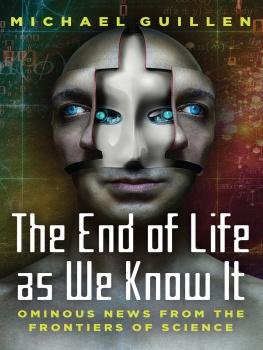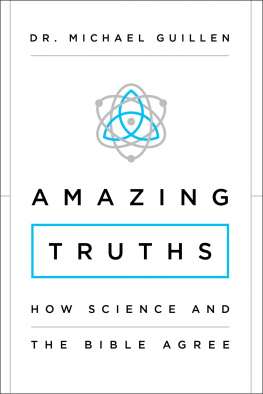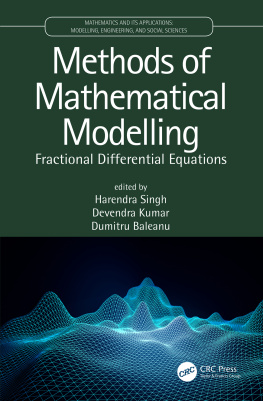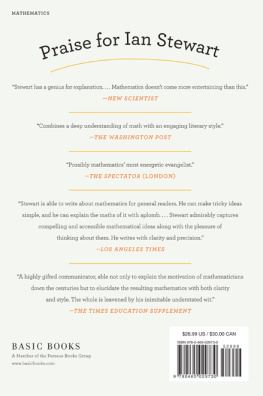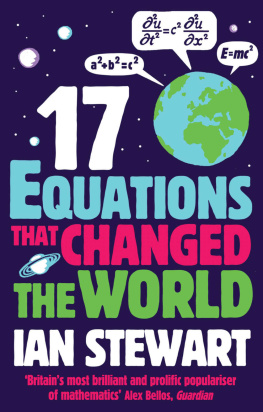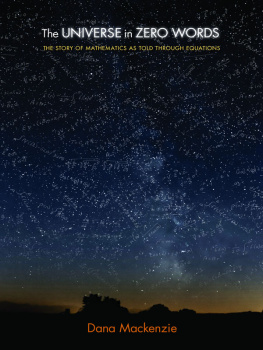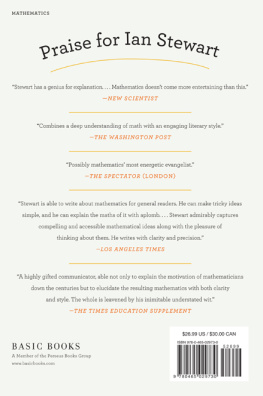Five Equations That Changed the World
The Power and Poetry of Mathematics
Michael Guillen, Ph.D.

New York
To Laurel, who changed my world for the better
Contents
Poetry is simply the most beautiful, impressive, and widely effective mode of saying things.
M ATTHEW A RNOLD
Mathematics is a language whose importance I can best explain by starting with a familiar story from the Bible. There was a time, according to the Old Testament, when all the people of the earth spoke in a single tongue. This unified them and facilitated cooperation to such a degree that they undertook a collective project to do the seemingly impossible: They would build a tower in the city of Babel that was so high, they could simply climb their way into heaven.
It was an unpardonable act of hubris, and God was quick to visit his wrath on the blithe sinners. He spared their lives, but not their language: As described in Genesis 11:7, in order to scuttle the blasphemers enterprise, all God needed to do was confound their language, that they may not understand one anothers speech.
Thousands of years later, we are still babbling. According to linguists, there are about 1,500 different languages spoken in the world today. And while no one would suggest that this multiplicity of tongues is the only reason for there being so little unity in the world, it certainly interferes with there being more cooperation.
Nothing reminds us of that inconvenient reality more so than the United Nations. Back in the early 1940s, when it was first being organized, officials proposed that all diplomats be required to speak a single language, a restriction that would both facilitate negotiations and symbolize global harmony. But member nations objectedeach loath to surrender its linguistic identityso a compromise was struck; United Nations ambassadors are now allowed to speak any one of five languages: Mandarin Chinese, English, Russian, Spanish, or French.
Over the years, there have been no fewer than 300 attempts to invent and promulgate a global language, the most famous being made in 1887 by the Polish oculist L. L. Zamenhof. The artificial language he created is called Esperanto, and today it is spoken by more than 100,000 people in twenty-two countries.
However, as measured by the millions of those who speak it fluently and by the historic consequences of their unified efforts, mathematics is arguably the most successful global language ever spoken. Though it has not enabled us to build a Tower of Babel, it has made possible achievements that once seemed no less impossible: electricity, airplanes, the nuclear bomb, landing a man on the moon, and understanding the nature of life and death. The discovery of the equations that led ultimately to these earthshaking accomplishments are the subject of this book.
In the language of mathematics, equations are like poetry: They state truths with a unique precision, convey volumes of information in rather brief terms, and often are difficult for the uninitiated to comprehend. And just as conventional poetry helps us to see deep within ourselves, mathematical poetry helps us to see far beyond ourselvesif not all the way up to heaven, then at least out to the brink of the visible universe.
In attempting to distinguish between prose and poetry, Robert Frost once suggested that a poem, by definition, is a pithy form of expression that can never be accurately translated. The same can be said about mathematics: It is impossible to understand the true meaning of an equation, or to appreciate its beauty, unless it is read in the delightfully quirky language in which it was penned. That is precisely why I have written this book.
This is not so much an offspring of my last book, Bridges to Infinity: The Human Side of Mathematics, as it is its evolutionary descendant. I wrote Bridges with the intention of giving readers a sense of how mathematicians think and what they think about. I also attempted to describe the languagethe numbers, symbols, and logicthat mathematicians use to express themselves. And I did it all without subjecting the reader to a single equation.
It was like sweet-tasting medicine offered to all those who are afflicted with math anxiety, individuals who normally would not have the courage or the curiosity to buy a book on a subject that has consistently frightened them away. In short, Bridges to Infinity was a dose of mathematical literacy designed to go down easily.
Now, emboldened by having written a successful book that contains no equations, I have dared to go that one step further. In this book I describe the mathematical origins of certain landmark achievements, equations whose aftereffects have permanently altered our everyday lives.
One might say I am offering the public a stronger dose of numeracy, an opportunity to become comfortably acquainted with five remarkable formulas in their original, undisguised forms. Readers will be able to comprehend for themselves the meaning of the equations, and not just settle for an inevitably imperfect nonmathematical translation of them.
Readers of this book also will discover the way in which each equation was derived. Why is that so important? Because, to paraphrase Robert Louis Stevenson: When traveling to some exotic destination, getting there is half the fun.
I hope that the innumerate browser will not be scared off by the zealousness of my effort. Rest assured, though these five equations look abstract, most certainly their consequences are notand neither are the people associated with them: a sickly, love-starved loner; an emotionally abused prodigy from a dysfunctional family; a religious, poverty-stricken illiterate; a soft-spoken widower living in perilous times; and a smart-alecky, high school dropout.
Each story is told in five parts. The Prologue recounts some dramatic incident in the main characters life that helps set the tone for what is to follow. Then come three acts, which I refer to as Veni, Vidi, Vici. These are Latin words for I came, I saw, I conquered, a statement Caesar reportedly made after vanquishing the Asian king Pharnaces. Veni is where I explain how the main characterthe scientistcomes to his mysterious subject; Vidi explains historically how that subject came to appear so enigmatic; Vici explains how the scientist manages to conquer the mystery, resulting in a historic equation. Finally, the Epilogue describes how that equation goes on to reshape our lives forever.
In preparing to write this book, I selected five equations from among dozens of serious contenders, solely for the degree to which they ultimately changed our world. Now, however, I see that the stories attached to them combine fortuitously to give the reader a rather seamless chronicle of science and society from the seventeenth century to the present.
As it turns out, that is a crucial period in history. Scientifically, it ranges from the beginning of the so-called Scientific Revolution, through the Ages of Reason, Enlightenment, Ideology, and Analysis, during which science demystified each one of the five ancient elements: Earth, Water, Fire, Air, and Ether.
In that critical period of time, furthermore, we see: God being forever banished from science, science replacing astrology as our principal way of predicting the future, science becoming a paying profession, and science grappling with the ultra-mysterious issues of life and death and of space and time.
In these five stories, from the time when an introspective young Isaac Newton sits serenely beneath a fruit tree to when an inquisitive young Albert Einstein nearly kills himself scaling the Swiss Alps, we see science wending its way from the famous apple to the infamous A-bomb. Which is to say, we see science going from being a source of light and hope to its also becoming a source of darkness and dread.


